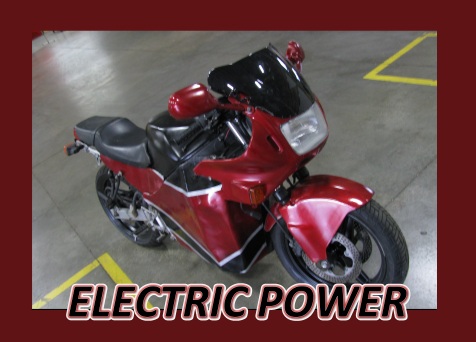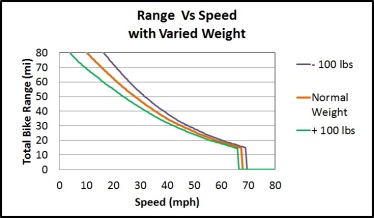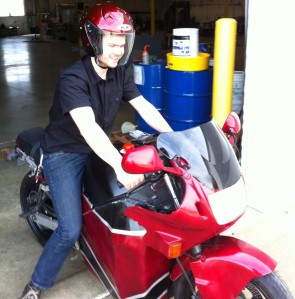I’ve been working late into the night for the last two weeks attempting to meet a contest deadline. All I did this weekend was document a project I built almost 2 years ago. The Instructables ‘Move It’ contest calls for all projects involving wheels and a motor. So I figured my electric motorcycle conversion would probably qualify.
What started as a passing interest ended up being a 6 month design & build research project and a $3,200 personal expense. While do-it-yourself grade electric motorcycles have been done before, I realized that the online EV community lacked the resources one would need to optimize an EV design. So I have attempted to share some of the awesome information I figured out in down to earth terms.
Free Design & Build Instructions Here.
Final Bike Specs:
- Batteries: (4) 80 Amp-hr AGM Lead Acid (Werker Brand)
- Motor: PMDC Brushed ME1004 (10.75 hp continuous)
- Direct Drive via Roller Chain
- Controller: Alltrax AXE4855 (250 amp continuous.)
- Final Bike Curb Weight: 453 lbs. (43 lbs. heavier than pre-conversion)
- Donor bike: 1989 Honda cbr600
- Typical Driving Range: ~25 miles (varies with speed)
- Top Speed: ~60 Mph
- MPG equivalent: 219
- Total Operating Cost:
- Project Cost: $3,200
.
Probably the most surprising and arrogant sounding thing I learned from this project was that physically building an EV is not that difficult to do. As I said, it’s all been done before. All the parts required to do it are straight off the shelf and come with manufacturer instructions on how they work. (It’s like they want you to be able to use their products.) If you have some background in making stuff then building an EV is simply a matter of applying your existing skills.
The hardest part was staying disciplined enough to work on this labor intensive project after a full day at the office.
.
The design and optimization portion of this project involved me wasting away in front a computer for hours on end. The funny thing is that despite all the detailed calculations I did, I could have just used a single rule of thumb to estimate the performance instead. (That reminds me of something else). Electric motorcycles consume about 100 Watt-hr/Mile, and that’s most of what you need to know to estimate range.
Speaking of range, the first thing everyone asks me is ‘how far can this thing can go?’ To that I say, range varies with how fast you drive. All vehicles consume more power with higher speeds due to wind resistance, so the range of any vehicle varies with your cruising speed.
Because I figured out how to calculate the range for a given speed in excel, it wasn’t long before I decided to graph the range for any speed. I also plotted the effects of varying gear ratio, weight, and aerodynamic drag on range too!
When I was changing those variables I realized that picking the correct gear ratio is the single most important thing you can do to maximize top speed. Because the bike has a fixed ratio chain drive instead of a transmission, picking the wrong gear hinders performance by maxing out the motor speed or torque before the max power output is achieved. As seen in that first graph, even slightly different gear ratios can result in a lower top speed.
.
The second question people usually ask me is if the bike has regenerative braking, and they always look disappointed when I say no. The truth is that regenerative braking is not always economically viable. The overall value of ‘regen’ depends on your specific circumstances.
Adding regen to my bike would have gained me an estimated 1.7 miles of range (a 6% increase), but doing so would have cost me an additional $700! (A 30% increase in total project cost).
To see if that was worth it I calculated the miles gained per dollar spent of adding regen versus just buying larger batteries to see where the money was best spent. I discovered that the money was 25 times better spent on buying bigger batteries than by adding regen! Literally every $1 spend on batteries bought an extra 1/500th of a mile range.
.
Despite spending 600 of those dollars on batteries, they were still the single biggest limiting factor on performance. No surprise there for anyone familiar with EVs. Lithium batteries would have improved the performance, but would have doubled the cost of the whole project and greatly increased it’s complexity.
It will take a revolution in battery technology to make a DIY motorcycle conversion practical. To be honest, as it is a DIY electric motorcycle is terribly impractical. Heck, even the $16,000 name brand EV motorcycles can’t compete with a conventional gas powered motorcycle or moped.

And nothing says “I’m an adult” quite like a moped.
My motorcycle had all the disadvantages of car mixed with a bicycle. You can’t drive it on sidewalk and you have to get it licensed, but you still can’t haul very much. The range was also too limited for my daily commute and recharging the battery took all night. Only I knew how to work on it and the finished vehicle didn’t have a warranty of any kind. I couldn’t even sell the thing whole without fear of a lawsuit down the road. I had to take it apart and sell it piecemeal at a huge loss.
For those reasons a DIY electric motorcycle is a terrible financial investment.
That’s OK though, I hadn’t planned on this project being a direct financial gain. An EV is a labor of love. Most people do conversions out of environmental concern. For me, the money also an investment in myself, and in that it was well spent. I gave myself the chance to take on a project that had intimidated me and I learned all this neat stuff because of it. As an engineer, this project hasn’t hurt my career prospects either.
.
In retrospect a smaller EV makes for a better mode of transportation. From an environmental standpoint you are always better off if you can use a small vehicle rather than a large one. For this reason, micro-electric vehicles are within the Goldilocks range of practical DIY EV design.
Things like EV bicycles are cheap, simple, and efficient enough to make sense environmentally, practically, and financially. If you want to DIY something, stick with vehicles small enough to not need a license or registration to legally drive.
But…But…This is ‘Merica, we LIKE to drive big vehicles
A smaller EV would also have been good for me because I learned that motorcycles scare the shit out of me. There is nothing between you and the road, so going 60mph on a small machine you screwed with is a feeling like no other. Especially considering that the conversion raised the center of mass on the bike making it harder to handle.
One time it rained while I was out and I almost took a spill at 30mph. Nope. NOPE. Done. That’s probably why my dad calls them murdercycles.
.
Was that not 10 lessons? Oh whatever. All that matters is that I learned some number of things greater than zero from this project. Hopefully at this point you have too!
That guy right there wants you to vote for his project in this contest.
(Clearly I have found instructables contests to be a fun creative outlet!)
Update 7-24-15: This project won second prize in the contest, thanks for your help everybody!






Reblogged this on How I see the world.
LikeLike
Wow! You did a nice job mate..!
LikeLiked by 1 person
[…] for the good part of the story: I’ve improved my electrical engineering skills a bit since high school and I’ve come up with a fire prevention device I’m calling The Smoke Detector […]
LikeLiked by 1 person
Nice job. You’ve discovered why, after writing From Smoke to Mirrors, I continue following progress toward solar crude oil. I’m far less concerned now, than I was in the 1980s, about the environmental impacts of gasoline-powered vehicles. Why? Greenies hate cars. I mean really… really… really… hate the s*** out of them. Never mind all the good things they’ve done for us. (Maybe greenies want to be dirt-poor with 24-year life expectancy). But… Salespeople, even car salespeople, like to please as many people as possible. Result: Marketing people keep pushing engineers to make cars cleaner and better. Sure – fossil gasoline causes warming. We know how to fix that. The question is: how do we convince non-technical people? Anyway, like I said, nice bike.
LikeLike
[…] end of the day. This was a big problem for me at home for a long time and I even designed an entire electric motorcycle conversion while crouching over a coffee table. My lower back pain inspired me to build a custom desk for home […]
LikeLike
[…] my electric motorcycle project, e-bikes are a very environmentally friendly and practical mode of transportation. Bicycles are […]
LikeLike
[…] ***It’s interesting to note the form factor similarities between the recurring champs of two different shows: Tombstone of the American BattleBots, and Carbide of British RobotWars. Also interesting that the weapon drive motor tombstone uses is of the same motor family (albeit 6p vs 12hp) that I used in my electric motorcycle conversion…! […]
LikeLike
You sound a lot biased against your own project. The reason is because you cheaped on the batteries and after all that work, ended up with a useless range. Next time remember that 700 extra dollars are not worth to sacrifice the whole effort Don’t be cheap!
LikeLike